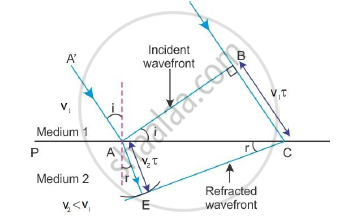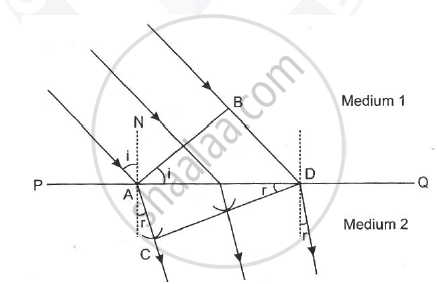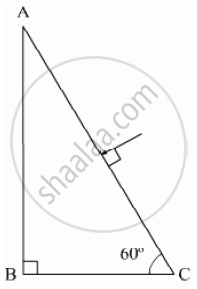Advertisements
Advertisements
प्रश्न
Derive Snell’s law on the basis of Huygen’s wave theory when the light is travelling from a denser to a rarer medium.
Using Huygen’s wave theory, derive Snell’s law of refraction
उत्तर १
Let PP′ represent the surface separating medium 1 and medium 2, as shown in the figure below.

Let v1 and v2 represent the speed of light in medium 1 and medium 2, respectively. We assume a plane wavefront AB propagating in the direction A′A incident on the interface at an angle ‘i’ as shown in the figure. Let τ be the time taken by the wavefront to travel the distance BC. Thus, BC = v1t
To determine the shape of the refracted wavefront, we draw a sphere of radius v2τ from the point A in the second medium (the speed of the wave in the second medium is v2 > v1).
Let CE represent a tangent plane drawn from the point C on to the sphere. Then, AE = v2τ and CE would represent the refracted wavefront. If we now consider the triangles ABC and AEC, we readily obtain
`sini=(BC)/(AC)=(v_1t)/(AC) `
`sinr=(AE)/(AC)=(v_2t)/(AC) `
where i and r are the angles of incidence and refraction, respectively. Therefore, from equations (1) and (2), we get
`sini/sinr=(v_1t)/(AC)xx(AC)/(v_2t)=v_1/v_2 `
From the above equation, if r > i (i.e. if the ray bends away from the normal), the speed of the light wave in the second medium (v2) will be greater than the speed of the light wave in the first medium (v1).
Now, if c represents the speed of light in vacuum, then
`n_1=c/v_1`
`n_2=c/v_2`
These are known as the refractive indices of medium 1 and medium 2, respectively. In terms of the refractive indices, equation 3 can be written as
`sini/sinr=v_1/v_2=c/n_1xxn_2/c`
∴ n1sini=n2sinr
This is the Snell’s law of refraction.
उत्तर २
Laws of Refraction: Consider a plane wavefront AB incident on a surface PQ separating two
media (1) and (2). The media (1) is rarer, having refractive index n1, in which the light travels with a velocity c1. The medium (2) is denser, having refractive index n2, in which the light travels with a velocity c2.

At time t = 0, the incident wavefront AB touches the boundary separating two medium at A.The
secondary wavelets from point B advance forward with a velocity c1, and after time t seconds
touches at D, thus covering a distance BD = c1t. In the same time interval of t seconds, the secondary
wavelets from A, advance forward in the second an envelope is drawn to obtain a new refracted
wavefront as CD.
Consider triangle BAD and ACD,
`sin i = sin(amgleBAD) = (BD)/(AD) = (c_1t)/(AD)`
`sin r = sin(angleADC) = (AC)/(AD) = (c_2t)/(AD)`
`=> sini/sinr = (c_1t)/(c_2t) = c_1/c_2`
`=> sin i/sin r = c_1/c_2` = constant
This constant is called the refractive index of the second medium with respect to the first medium.
`c_1/c_2 = n_1/n_2`
`:. sin i/sin r =c_1/c_2 = n_2/n_1 = ""_1n_2 `
This is known as the Snell’s law.
संबंधित प्रश्न
Calculate the speed of light in a medium whose critical angle is 45°. Does critical angle for a given pair of media depend on the wavelength of incident light ? Give reason.
Trace the path of a ray of light passing through a glass prism (ABC) as shown in the figure. If the refractive index of glass is `sqrt3`, find out the value of the angle of emergence from the prism.

Use Huygens’ geometrical construction to show the propagation of plane wavefront a rarer medium (1) to a denser medium (2) undergoing refraction.
Hence derive Snell’s law of refraction.
Find a critical angle for glass and water pair, given the refractive index of glass, is 1 ·62 and that of water is 1 ·33.
Define the term, “refractive index” of a medium. Verify Snell’s law of refraction when a plane wavefront is propagating from a denser to a rarer medium. Solution
Answer the following question.
Define the term, "refractive index" of a medium. Verify Snell's law of refraction when a plane wavefront is propagating from a denser to a rarer medium.
A small bulb is placed at the bottom of a tank containing water to a depth of 80 cm. What is the area of the surface of water through which light from the bulb can emerge out? Refractive index of water is 1.33. (Consider the bulb to be a point source.)
For small angles Snell’s law becomes ______.
Using Huygen’s wave theory of light, prove Snell’s law of refraction of light.
Draw the shape of refracted wavefront when the plane incident wave undergoes refraction from optically denser medium to rarer medium. Hence prove Snell’s law of refraction.
The mixture a pure liquid and a solution in a long vertical column (i.e, horizontal dimensions << vertical dimensions) produces diffusion of solute particles and hence a refractive index gradient along the vertical dimension. A ray of light entering the column at right angles to the vertical is deviated from its original path. Find the deviation in travelling a horizontal distance d << h, the height of the column.
If light passes near a massive object, the gravitational interaction causes a bending of the ray. This can be thought of as happening due to a change in the effective refractive index of the medium given by n(r) = 1 + 2 GM/rc2 where r is the distance of the point of consideration from the centre of the mass of the massive body, G is the universal gravitational constant, M the mass of the body and c the speed of light in vacuum. Considering a spherical object find the deviation of the ray from the original path as it grazes the object.
A ray of light is incident on a glass prism of refractive index µ and refracting angle A. If it just suffers total internal reflection at the other face, obtain a relation between the angle of incidence, angle of prism and critical angle.
